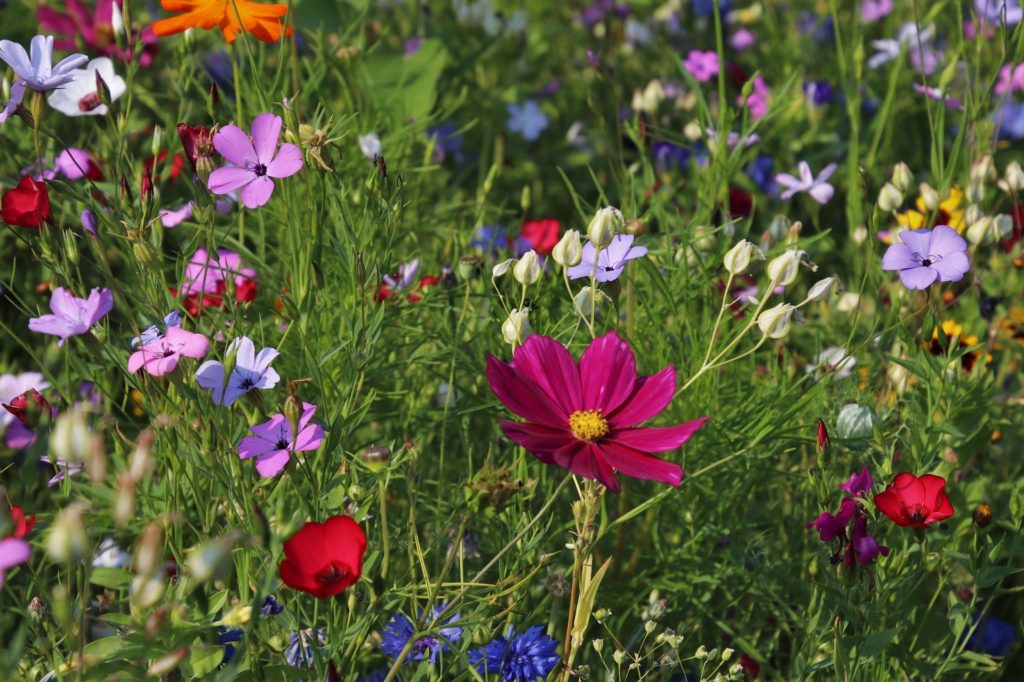“A meadow is a field which has grass and flowers growing in it.”
Collins Dictionary
A meadow can be a low-maintenance, low-water area full of grasses and flowers to attract and provide for friendly wildlife like pollinators, birds, and toads. Its vegetation cover and roots allow more rainwater to be absorbed into the soil rather than become runoff. That gets more water into our soils and aquifers.
Meadows also have a wild and natural beauty for us to enjoy, that encourage us to slow down and relax, and to observe some nature up close. Plus, they can provide a supply of fresh-cut flowers throughout the season.
There are many types of meadows
The most natural are the open places that collect and absorb snowmelt and rainwater, holding it and releasing it slowly to waterways. These places are rich with wildlife activity and essential to wildlife.
But a new definition of meadow has arisen in Europe and in the US that responds to the decline we’ve been seeing in pollinators and other insects, birds, and native plants. They’re called urban meadows, and are often established in landscapes, parks, or former lawns. Public meadows serve as teaching and observation spots about biodiversity.
Mike Lizotte, of American Meadows seed company, calls small meadows you can work into your garden or landscape “mini meadows”. These can be a few acres large or as small as a raised garden box, or as tiny as a collection of pots. And they can consist of only flowers.
For anyone who likes the idea of a low-water, low-maintenance, colorful, life-affirming, pollinator feeding, mesmerizing spot in their yard that also delivers fresh-cut flowers, a meadow is a project to try.
What flowers to grow in your meadow
My last article, “Grow You Own Meadow Garden at Home”, offered some native perennial grasses and sedges to use that are low-water and low-maintenance. Worked into or around the grassy area, or without the grassy area, are the flowers.
The flowers are the fun part. What you’ll get is a rambunctious collection of easy to grow flowers that will reseed and need no replanting. Include both annuals and perennials, both native and non-native.
Including natives is always best for many insects and the birds that feed on them. Don’t forget my constant reminder to use Calscape.org for all you need to know on what plants are native to your exact address, and nurseries that sell them.
Using Calscape.org, make a list of flowers that grow in your spot with the sun you have. Please note that full sun is defined by 6 or more hours of direct sun. No less! Otherwise it’s part shade to shade.
For larger meadows that are near the wilder lands I recommend more of the native wildflowers, they’ll take less water, are more deer resistant, and if they venture out into the wild it’s ok.
Next you can choose a wildflower seed mix. Select a mix that’s designed for the Pacific Northwest for our area. If there are some natives you’d like to be sure to include you may be able to get them separately. There are many seed mixes now that are for meadows and many include both annuals and perennials.
Wildflower mixes often include non-native flowers and that’s ok. They’re included because of their low maintenance needs, quick and easy establishment, as well as for their value to pollinators, and often for deer resistance. See your local nursery for a selection.
Annual flowers for a small space in a garden bed can include cosmos, Flander’s poppies (Papaver rhoeas), zinnias, cornflowers, sweet allysum, even sunflowers.
One rule to heed is to always go for the single flowers, not a fuller double version. This is because the double flowers hide or block access for the pollinators to the pollen and nectar source. So stick with singles!
A few good perennials for our area include Echinacea, California poppies (yes, they’re perennial!), lupines, Gaillardia, Shasta daisies, Santa Barbara Daisies, California Fuschia (Zuaschneria californica), and Goldenrod (Solidago), Black-eyed Susans (Rudbeckia hirta), columbine, and asters.
If you have the space, surround your meadow with native shrubs

To add even more habitat to your meadow—and shade or privacy for you in the meadow, consider a few native shrubs to surround the meadow. A few that would be good are coffeeberry (Frangula californica), toyon, carpenteria (Carpenteria californica), Red Flowering Currant (Ribes sanguineum and many others), manzanitas (Howard McMinn and low growing Pt. Reyes), and native bunchgrasses like California Fescue.
Shrubs offer more food in the form of flowers, berries, and seeds as well as shelter and nesting sites for birds and other small animals.
Starting a meadow may be a bit of work
How much work depends on the condition of the site. But after it’s established you’ll have very little work to do. I’ll discuss how to start a meadow in my next article.
But you’ll end up with a beautiful spot, large or small, for some wildlife viewing: birds, bees of all sorts, butterflies, moths, skippers, and hummingbirds. You’ll be helping them to thrive.
You’ll get flowers for bouquets in your home.
And you’ll get lots of opportunity for wonder for the children in your life!

